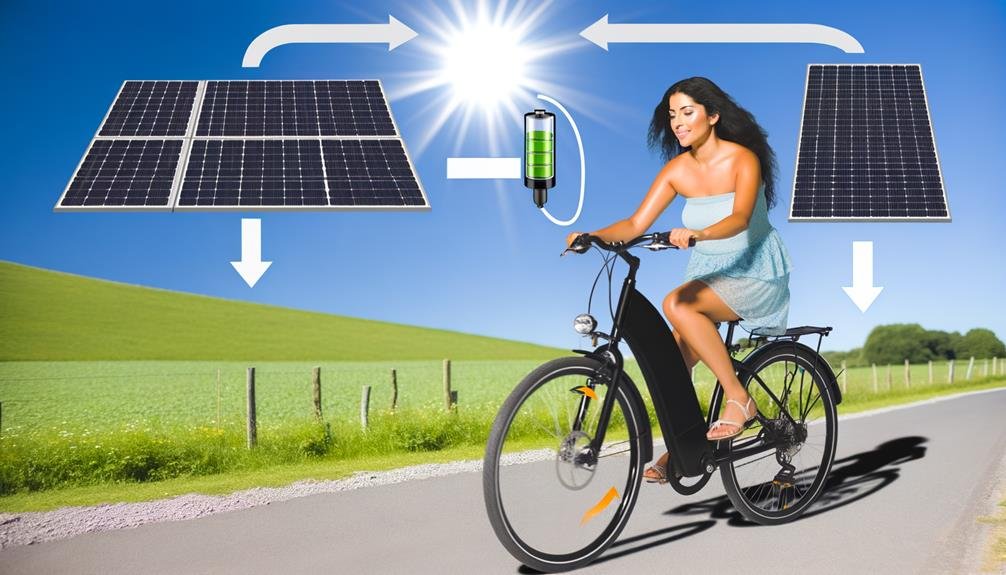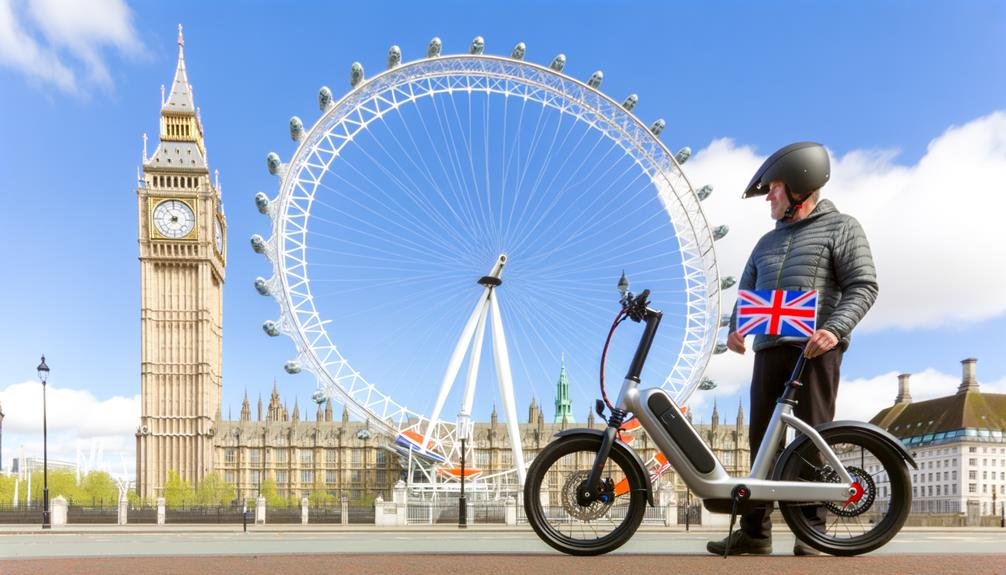Charles Miller is a veteran bike enthusiast with over 12 years of experience dealing with bikes as a mechanic. Despite immense love and expertise for...
Imagine effortlessly gliding down a picturesque hillside on your e-bike, the wind teasing your hair, all while your bike silently powers itself back up.
Sounds like a futuristic dream, doesn't it?
We're here to delve into the captivating question: Can you charge an e-bike while riding it?
While the straight answer might seem rather simple, the discussion unravels a complex tapestry of technology, innovation, and the constant human pursuit of convenience and efficiency.
So, shall we embark on this electrifying journey to uncover the reality and potential of charging e-bikes on-the-go?
Key Takeaways
- Traditional e-bikes require manual handling and detachment of the battery for charging, limiting their usability if far from a power source.
- Regenerative braking, available only in e-bikes with direct-drive hub motors, converts kinetic energy into electricity and stores it in the battery, making it more effective during downhill rides.
- Solar panels on e-bikes offer a sustainable way to charge the battery, particularly suitable for long-distance tours and remote areas, although their cost and reliance on sunlight effectiveness can be factors to consider.
- Some innovative e-bike models are exploring self-charging capabilities by harnessing kinetic energy during braking or descending, although these options are limited in availability and can be expensive.
Understanding Traditional E-bike Charging
Typically, the charging process of e-bikes involves detaching the battery from the bike and connecting it to a traditional charging port. To recharge the battery, it's plugged into a power source, much like you'd charge a smartphone or laptop. This is what we refer to as traditional e-bike charging. It's a straightforward process, but it does require a level of manual handling.
The battery is usually located in a convenient spot on the bike for easy detachment. Once removed, you connect the battery to the charging station. It's a simple process, but you do need to be near a power source. This can be limiting if you're out on a long ride or far from a convenient power source.
The question of whether you can charge an ebike while riding is a common one. With traditional e-bike charging, the answer is no. The design doesn't allow for recharging while the bike is in use. The battery must be detached, charged, and then reattached before you can continue your ride.
Despite this limitation, the simplicity and reliability of traditional e-bike charging make it a popular choice for many e-bike users.
Exploring Regenerative Braking
While traditional e-bike charging methods don't support power replenishment during a ride, an alternative solution exists in the form of regenerative braking, a technology that allows some e-bikes to partially recharge their batteries while in motion. Regenerative braking systems convert the kinetic energy generated during braking into electricity, contributing to a small percentage of the ebike's charge.
This technique is only possible with e-bikes equipped with direct-drive hub motors, a feature that has existed for about two decades. How does it work? When the brake sensors are triggered, the motor switches to reverse mode, enabling regenerative braking. The energy produced during this process is captured and stored in the battery, ensuring no energy is wasted.
It's important to note that regenerative braking doesn't damage your ebike's brakes. In fact, it can even be more effective during downhill rides when more kinetic energy is converted.
Despite these advantages, it's worth mentioning that most e-bikes don't utilize this technology due to motor limitations and cost considerations. As we continue to innovate and improve, we're hopeful more models will incorporate this energy-saving feature in the future.
Solar Panels on E-bikes

Harnessing the power of the sun, solar panels affixed to an e-bike's frame or backpack offer a green and convenient method to recharge the battery while on the go. These panels generate energy from sunlight, providing an eco-friendly alternative to conventional charging methods. As you use your electric bike, the solar panels work to keep your battery charged and extend your ride.
Benefits of using Solar Panels on E-bikes:
- They offer a sustainable way to charge your ebike battery, especially for long-distance tours.
- Solar charging provides independence from public energy supply, making it ideal for remote areas.
- Although they're an investment, the cost can be offset by the savings on electricity.
- Panels with at least 37W output are suitable for e-bikes, with higher outputs offering faster charging.
The Self-charging E-bike Innovation
How about delving into the promising world of self-charging e-bikes? This relatively new innovation is an exciting development in the world of electric bikes. The concept revolves around harnessing kinetic energy, which is typically wasted during braking or descending, to recharge the battery pack.
The idea of having e-bikes recharged while riding is still in its infancy, but we're already seeing some promising prototypes. Notably, models such as the Byar Volta, Pi-Pop, and Vello Bike+ are exploring this potential. These bikes use an integrated system where the electric motor works in reverse during braking or descending, converting kinetic energy into electrical energy to top up the battery charge.
However, there's a catch. These models are currently not widely available and can be expensive. Also, the amount of energy they can recover is fairly limited. The regenerative braking method, for instance, provides only a small percentage of battery charge.
In a nutshell, the potential for self-charging e-bikes is there, but the technology is still in its early stages. As such, for the time being, traditional charging methods remain the most viable option. Yet, with continuous innovation, the future of self-charging e-bikes looks bright.
Benefits and Downsides of Charging While Riding

Let's delve into the advantages and drawbacks of charging an e-bike on the move, a concept that's gaining traction in the world of sustainable transportation.
Modern e-bikes, equipped with regenerative braking, allow riders to recover energy while they ride downhill or come to a halt, enabling them to use the bike for longer distances. Generally speaking, this technology enhances the efficiency of electric bicycles and promotes sustainability.
However, there are a few points to consider:
- Regenerative braking offers minimal charging on flat terrain or when riding uphill; its effectiveness depends on braking frequency and speed.
- Experimental models like the Byar Volta and Vello Bike+ use innovative technology for automatic recharging while riding, adding convenience.
- The energy-efficient and environmentally friendly nature of charging while riding reduces the need for frequent stops to get fully charged.
- Solar panels offer an eco-friendly way to recharge, but their effectiveness depends on sunlight, and they can be relatively expensive.
When deciding to Buy An Electric bike, it's essential to weigh these factors. Charging while riding offers significant benefits, but understanding its limitations can ensure you make a well-informed decision.
Frequently Asked Questions
Can You Charge Your Ebike While Riding It?
"We can't charge our ebikes while riding currently. Despite regenerative braking benefits and energy efficiency improvements, battery lifespan considerations, charging system advancements, safety concerns and infrastructure development impact our ability to do so."
How Do You Charge an Ebike While Traveling?
We're navigating the ebike charging maze together. We use travel chargers, locate charging stations, explore battery swap options, use dynamo methods, carry portable chargers, plan overnight charging, and even explore motorhome charging. It's an electrifying journey!
Can You Solar Charge an Ebike While Riding?
Yes, we can solar charge an ebike while riding. With efficient solar panels, optimal placement, and good weather, the charging speed can be quite decent. Ebike solar kits and portable solar chargers make this possible.
Can Ebikes Recharge From Pedaling?
We're sad to say, but ebikes can't recharge from pedaling alone. Current ebike technology primarily uses outlet charging and regenerative braking for power conversion, enhancing pedaling efficiency and battery lifespan for sustainable commuting.
Conclusion
In a nutshell, we can't charge most e-bikes while riding yet. Current innovations like regenerative braking and solar panels are promising, but they're still in their infancy and can be pricey.
It's clear that there's no such thing as a free lunch, and we need to find a balance between convenience, cost, and technology. But as advancements continue, we're optimistic that soon recharging an e-bike while riding will be as common as pedaling on a traditional bike.

Charles Miller is a veteran bike enthusiast with over 12 years of experience dealing with bikes as a mechanic. Despite immense love and expertise for his Tacoma, he rides his Trek Ebike more. Anytime you meet him, you’ll either hear him talking about Bikes, or writing about all things bikes and cars on this blog.
More Posts


